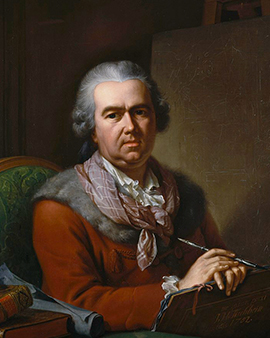Johann Heinrich Tischbein came from simple circumstances. His natural, extremely great talent for drawing emerged early on - although the family had no money for paper or chalk. Thus the young Johann Heinrich painted on the kitchen table, which was inevitably wiped clean again and again.
Later he was apprenticed to a master wallpaper painter - and soon he turned out to be a lucky man, because by chance, Count von Stadion, the Grand Master of the Elector of Mainz, recognized Tischbein's oversized talent. The Count now acted as a patron and made it possible for the young Tischbein to take lessons with well-known artists of the time. In 1743 Johann Heinrich Tischbein went to Paris for five years.
In the metropolis on the Seine, Tischbein took lessons with France's renowned history painters Jean Restout and Carle Vanloo as well as with the renowned portrait painter Nicolas de Langilliere. Art studies later led him to Italy, where he met the fresco painter Giovanni B. Tiepolo and attended the drawing school of Giovanni Battista Piazzetta.
The French and Italian influences were to become clearer little by little in Tischbein's artistic work: This attitude, which was so popular, aroused great interest in contemporary aristocratic circles.
It was Wilhelm VIII of Kassel, the Landgrave of Hesse who was particularly fond of art, who appointed Tischbein as court painter. During this time Tischbein created important works in the segment of portrait and history painting and reached the peak of his artistic fame.
In 1762 Johann Heinrich Tischbein the Elder was appointed director of the "Collegium Carolinum" art academy by Landgrave Friedrich II of Hesse-Kassel, which still exists today. Tischbein's reputation was so great that he was subsequently able to train all the talented family members in painting.
As a result, the Tischbein family became a family of painters across the generations. Tischbein's nephews also became famous: Frankfurt's Johann Heinrich Wilhelm Tischbein (1751 to 1829) through his Goethe painting and Johann Friedrich August Tischbein through portraits of the rich citizens of Saxony.
Today art connoisseurs say: Johann Heinrich Tischbein the Elder and his family is to painting what the family around Johann Sebastian Bach is to music.
In a Tischbein biography, reference is made not only to the important artistic work but also to the master's eye complaint. In his later years Tischbein suffered from progressive blindness at close range. At this stage Tischbein selectively scanned the objects in order to reassemble the whole with the help of his trained powers of imagination. Accordingly, the artistic achievements in his later paintings were achieved by the great power of genius.
Against this background, Tischbein's artistic achievement in his last great painting, "Christ on the Mount of Olives", is particularly appreciated: He painted it almost blind and completed the painting a few months before his death in August 1789.
×





.jpg)
.jpg)
.jpg)
.jpg)
.jpg)
.jpg)
.jpg)
.jpg)
.jpg)
.jpg)
.jpg)
.jpg)
.jpg)
.jpg)
.jpg)
.jpg)
.jpg)
.jpg)
.jpg)
.jpg)
.jpg)
.jpg)
.jpg)
.jpg)
.jpg)
.jpg)
_-_(MeisterDrucke-1573359).jpg)
_-_(MeisterDrucke-1573359).jpg)
.jpg)
.jpg)
.jpg)
.jpg)
.jpg)
.jpg)
.jpg)
.jpg)
.jpg)
.jpg)
.jpg)
.jpg)
.jpg)
.jpg)
.jpg)
.jpg)
.jpg)
.jpg)
.jpg)
.jpg)
_-_(MeisterDrucke-1573361).jpg)
_-_(MeisterDrucke-1573361).jpg)
.jpg)
.jpg)
_-_(MeisterDrucke-1127486).jpg)
_-_(MeisterDrucke-1127486).jpg)
.jpg)
.jpg)
.jpg)
.jpg)
.jpg)
.jpg)
.jpg)
.jpg)
_-_(MeisterDrucke-592270).jpg)
_-_(MeisterDrucke-592270).jpg)
.jpg)
.jpg)
.jpg)
.jpg)
_-_(MeisterDrucke-959850).jpg)
_-_(MeisterDrucke-959850).jpg)
.jpg)
.jpg)
 - (MeisterDrucke-666503).jpg)
 - (MeisterDrucke-666503).jpg)
.jpg)
.jpg)
.jpg)
.jpg)
.jpg)
.jpg)
.jpg)
.jpg)
.jpg)
.jpg)
.jpg)
.jpg)
_Peinture_de_Johann_Heinrich_Wilhelm_Tischbein_-_(MeisterDrucke-1324878).jpg)
_Peinture_de_Johann_Heinrich_Wilhelm_Tischbein_-_(MeisterDrucke-1324878).jpg)
.jpg)
.jpg)
.jpg)
.jpg)
.jpg)
.jpg)
.jpg)
.jpg)
.jpg)
.jpg)
_-_(MeisterDrucke-1573360).jpg)
_-_(MeisterDrucke-1573360).jpg)
.jpg)
.jpg)
.jpg)
.jpg)
.jpg)
.jpg)
.jpg)
.jpg)
.jpg)
.jpg)
_-_(MeisterDrucke-1573365).jpg)
_-_(MeisterDrucke-1573365).jpg)
_Peinture_de_Johann_Hei_-_(MeisterDrucke-1320846).jpg)
_Peinture_de_Johann_Hei_-_(MeisterDrucke-1320846).jpg)
_-_(MeisterDrucke-592156).jpg)
_-_(MeisterDrucke-592156).jpg)
_-_(MeisterDrucke-1573366).jpg)
_-_(MeisterDrucke-1573366).jpg)
.jpg)
.jpg)
_-_(MeisterDrucke-1480926).jpg)
_-_(MeisterDrucke-1480926).jpg)
_-_(MeisterDrucke-1573362).jpg)
_-_(MeisterDrucke-1573362).jpg)
_-_(MeisterDrucke-1573364).jpg)
_-_(MeisterDrucke-1573364).jpg)
.jpg)
.jpg)
.jpg)
.jpg)
_-_(MeisterDrucke-1553927).jpg)
_-_(MeisterDrucke-1553927).jpg)
_-_(MeisterDrucke-1573363).jpg)
_-_(MeisterDrucke-1573363).jpg)






